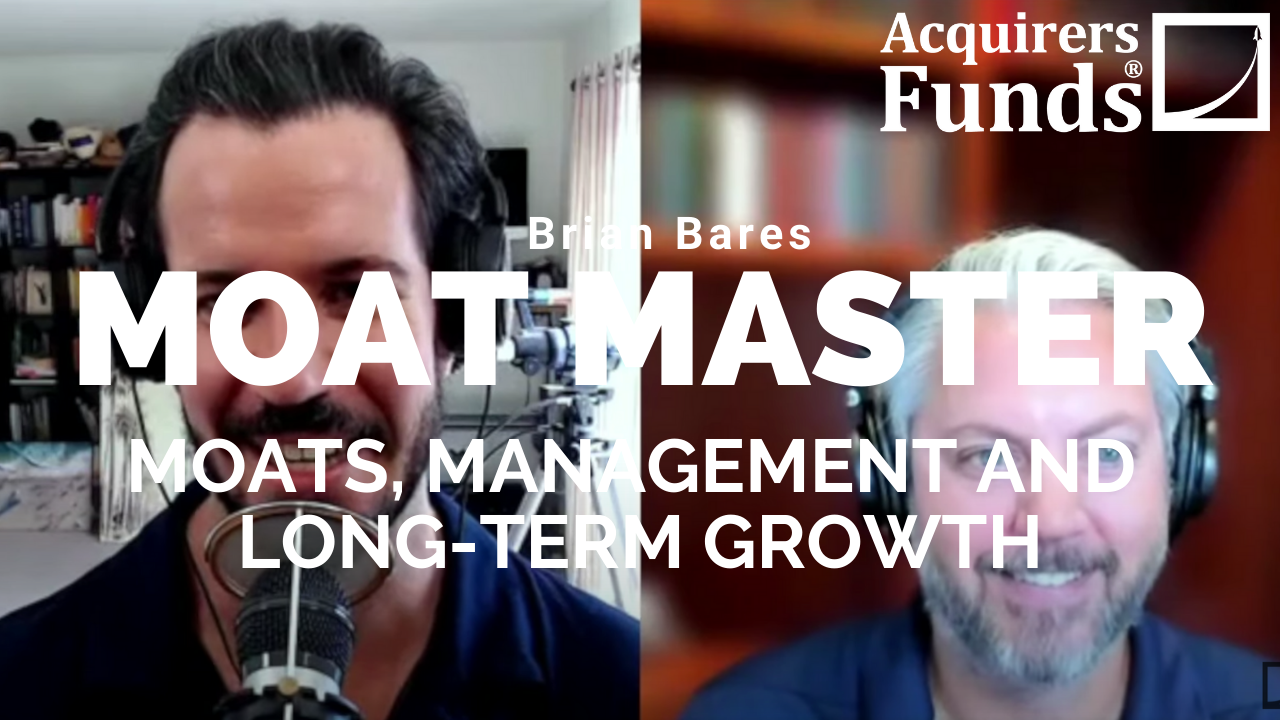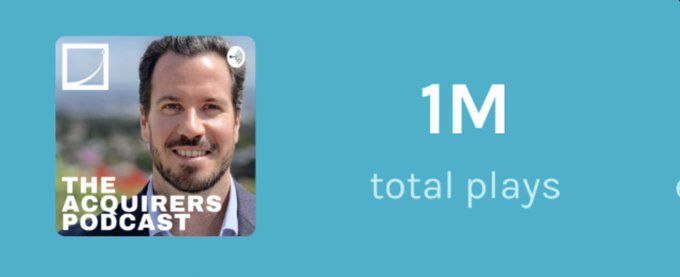During his recent interview with Tobias, Brian Bares, Founder of Bares Capital Management discussed why DCF Is The Least Reliable Part of a Manager’s Process. Here’s an excerpt from the interview:
Tobias: Let’s talk about valuation for a little bit. Your favorite DCF– and you have some hedging around that. But you’re like 10% cost of capital, which is reasonably high in the current market. So, perhaps just talk us through a typical valuation, then maybe I’ll just take you through the four names in your brochure.
Brian: I sent you the current brochure, so I hate to talk about current names, because this will be timestamped. Maybe we can talk about some historical names, or I can give you some examples to help–
Tobias: That’s why I didn’t mention them.
Brian: Yeah, [chuckles] thank you. The 10% discount rate embedded in our DCF is really reflective of it being an– First of all, it’s a recognition that there are inherent limitations in the DCF model itself. What we’re trying to do, what’s the point of a DCF is to try and get an approximate valuation of a company. By using 10%, what we’re doing is saying that’s the approximate return of the US stock market since 1926. So, if we come up with a valuation on a name, and we find that it is priced– we find that the appraisal matches the current stock price, we can reasonably say that going forward, we’re going to get market-like returns from this name. Does that make sense?
Tobias: Yeah. Absolutely.
Brian: Trying to use a common size measuring stick for all companies and get a feel for whether something is undervalued, overvalued, or appropriately valued when contrasted with the approximate returns we have seen from the US stock market since 1926. I’m not saying that this is the most perfect way that you can value a company, and I totally get that 10% is punitive, especially in the current environment, and we’ll extend a DCF out much longer than most people.
We will also hold names much longer than most people, even when we feel like the names have raised way past our intrinsic value estimates. The idea is to try and be disciplined on the buy when we have some variant perception, we feel like the name is reasonably cheap and then to say, “Okay, if we’re right about the valuation, and we buy it right, we’re going to get better than market returns going forward,” because that’s the whole game that we’re involved in. So, that’s why the 10%.
Sometimes, you have situations where– this is something that we have done a lot of navel-gazing, especially in the past five years is that, sometimes you have situations where we have approved names for our focus list, meaning that it has actually been one of the most exceptional qualitative names we’ve come across, we’ve approved it for purchase, we’ve done the valuation, and it just seems always too expensive to buy.
I think that’s a very common problem in our industry, especially in the current environment. It seems like things are just always too expensive to buy. What’s interesting is if you do some analysis around this, those names have actually in some cases performed even better than our portfolios which themselves have done really well. We sort of say we’re missing out on some of the best names because there’s perennially overvalued.
I have all these war stories where we’ve identified these names, Tyler Technologies and others, where we saw them when they were a couple of hundred million of market cap and we recognized them, we studied them, we approved them, met the management, got to know them, maybe did some user conferences, went to some industry tradeshows, we affirmed the competitive thesis around the name, and we just sat there sucking our thumb as a thing 10 times itself in the market, and we never got a chance to own it.
So, the valuation DCF piece of it is, in my opinion, the least reliable and accurate part of any managers’ process. It’s got artificial precision that everybody puts way too much weight in. It is for that reason that we incorporate a lot of the qualitative assessment of the individual businesses into the portfolio management decision-making itself. Unlike a lot of managers, they’ll say we’re going to rank-order our opportunity set from on price to intrinsic value. We’re going to sell the 100 cent dollars and buy the 60 cent dollars. Wash, rinse, repeat. We don’t do that.
Despite my math background, it’s very seductive to have a robust process like that. Your institutional clients would love to hear that stuff because it makes them feel comfortable that you’re not going rogue in any way. There’s a real structure and a process around it. But the sausage is made a little bit more–
Tobias: It’s messier.
Brian: Yeah, it’s a softer process than that. Company X at 80 cents on the dollar maybe a better bet than company Y at 70 cents on the dollar because you have a higher qualitative conviction in the management, in the future growth of the business, or the moat around the business. Again, we’re going back to what we’re paid for, we’re paid for that qualitative exceptionalism and the pre-approval process, but we’re also paid for the portfolio manager judgment in using price to intrinsic value as a piece but not a strict quantitative process in building the portfolio and weighting the portfolio. Does that make sense?
Tobias: Absolutely. There’s two interesting elements to what you’re doing there. One is that you say you extend the DCF out much longer than is typical. So, how long are you doing? What’s a typical DCF term for you?
Brian: Yeah. So, it just depends on the company. This actually goes back to a comment about the DCF itself. But if you have very predictable free cash flow dynamics– for example, we owned a micro-cap company a long time ago that did the dental practice, software and operations and things like that. They had 20-year contracts with their dental practices. They had escalators built in the price.
It was just a very, very predictable business. it was a static cost structure. You could map it out and you could get free cash flow dynamics for that business. It was a great business, it wasn’t going to grow super quickly, but you could really be, in my opinion, fairly reliant on the DCF for that business. We actually did a pretty fair job of actually– I think we owned it three times with three round trips in that, were bought at 60 cents on the dollar, sold at maybe 120, 130 cents on the dollar, and did very, very well.
Then, we owned a 3D printing company, which was growing at 30% annually, and had just crazy growth dynamics. If you tried to map that thing out past year or three in the DCF, you might as well just be rolling a 100-sided dice. You have no idea what’s happening.
In the former, you could map that out to 10, 15, even 20 years and free cash flow and you can get a pretty reliable number for your appraisal. It’s not perfect, it never is, and lots of things change. But you could just be more reliant on that then in the case of a 3D print printing company. So, we try to keep that in mind. If we have high qualitative conviction and we think that the range of outcomes for growth is not normally distributed, but heavily skewed to the upside and we get a feel for what other people are expecting in terms of valuation and what our conservative appraisal is, we can buy incredibly high growth, dispersed outcome business without doing too much intense DCF work.
On the contrary, if we find a very predictable business that has very static-free cash flow dynamics. Tyler Technologies has software contracts with local court systems and municipalities. That’s a decent example of one where the DCF looks a little bit more predictable. We can extend that out 10, 15 years and we can kind of play with it and get a narrower range of appraisals that we can have higher confidence interval in. Does that make sense?
Tobias: Absolutely. You’re either pushing out the number of years that you know where something’s going to happen and perhaps having a smaller terminal value, or you have a shorter term and you have a chunkier terminal value. How do you think about those terminal values when you’re conducting the DCF?
Brian: Yeah, we try in our terminal value– we are incredibly, probably overly, penalizing companies. The reason why is, I don’t know if you’re familiar with Bruce Greenwald. He has a book called Competition Demystified. He’s Columbia professor. He’s got a great line in one of his books. He says, “In the end, everything’s a toaster.” What he means is, the gravity of competitive dynamics will come to get you eventually. When that happens, your economic margins disappear. In our opinion, that’s what terminal value is all about. It’s like what does the heat death of the universe for this company look like. It’s now going to be average at best. So, that’s what we try to do with our terminal values.
We’re not giving them any magic, grow-forever type of dynamics in there. But again, these are technical aspects of the DCF that I think over my 20-year career, I’ve spent more conceptual time on but less technical time on. In fact, we don’t spend a ton of time thinking about that stuff. We spend more time thinking about what is the competitive positioning in the marketplace? How is that changing? What does the threat of this new entrant mean for the incumbent that we’re investing in? What does it mean when management retires and moves on? What does it mean when they make an acquisition?
These more immediate qualitative impactful things are what we have to really, really pay attention to. And so, yes, we’re updating these DCFs every quarter and anytime there’s something material happening with the business, but our default mode is just stay the course. A buy or sell decision is more likely triggered by– well, a sell decision, in particular, is more likely triggered by a deterioration in one of these qualitative buckets than it is triggered by a something is 120 cents on the dollar in terms of our valuation.
We’re getting less reliant on the valuation as a driver for decision-making on the sell side. We still have it on the buy side because we want to be buy disciplined/ We don’t want to overpay for names, but once we hold them, we want to stay married to them. Divorce is going to happen because there’s some serious qualitative crack in the investment thesis.
You can find out more about the VALUE: After Hours Podcast here – VALUE: After Hours Podcast. You can also listen to the podcast on your favorite podcast platforms here:
For all the latest news and podcasts, join our free newsletter here.
Don’t forget to check out our FREE Large Cap 1000 – Stock Screener, here at The Acquirer’s Multiple:




